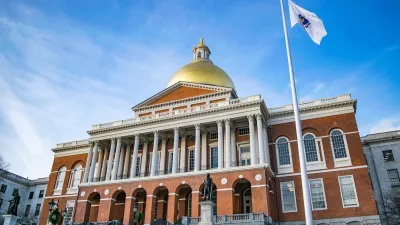Michigan—the state that spends less per capita on its roads than every other state—just got bad news about the state of its roads. Will it be enough to convince voters to pass a sales tax initiative to generate $1.2 billion in funding for roads?
"According to 2014 data from the Michigan Transportation Asset Management Council, only 17% of the state's roads are considered to be in good shape, 45% are in fair condition and 38% were considered to be in poor shape," reports Eric D. Lawrence.
The news precedes a May 5 ballot initiative before the state's voters "to decide on a complex measure that will raise the state sales tax to provide money for road repairs," adds Lawrence. Proposal 1, as its called, would raise $1.2 billion, but Lawrence indicates that the initiative's fate is far from certain. Planetizen correspondent Irvin Dawid elucidated the complexities of Proposal 1 in a January 30 article.
Lawrence provides details about the current political situation of Proposal 1 as well as providing a lot more detail about Michigan's current efforts to maintain and repair its transportation infrastructure. According to Lawrence, for instance, "Michigan spends less per capita on its roads than every other state, according to U.S. Census data, which said the state spent $126 per capita in 2012." That's a 6 percent drop since 2011 and it compares poorly with neighboring states. Ohio spends $258, Illinois $325, Indiana $339, Minnesota $241, and Wisconsin at $295.
FULL STORY: State of Michigan roads go from poor to terrible

Study: Maui’s Plan to Convert Vacation Rentals to Long-Term Housing Could Cause Nearly $1 Billion Economic Loss
The plan would reduce visitor accommodation by 25,% resulting in 1,900 jobs lost.

North Texas Transit Leaders Tout Benefits of TOD for Growing Region
At a summit focused on transit-oriented development, policymakers discussed how North Texas’ expanded light rail system can serve as a tool for economic growth.

Why Should We Subsidize Public Transportation?
Many public transit agencies face financial stress due to rising costs, declining fare revenue, and declining subsidies. Transit advocates must provide a strong business case for increasing public transit funding.

How to Make US Trains Faster
Changes to boarding platforms and a switch to electric trains could improve U.S. passenger rail service without the added cost of high-speed rail.

Columbia’s Revitalized ‘Loop’ Is a Hub for Local Entrepreneurs
A focus on small businesses is helping a commercial corridor in Columbia, Missouri thrive.

Invasive Insect Threatens Minnesota’s Ash Forests
The Emerald Ash Borer is a rapidly spreading invasive pest threatening Minnesota’s ash trees, and homeowners are encouraged to plant diverse replacement species, avoid moving ash firewood, and monitor for signs of infestation.
Urban Design for Planners 1: Software Tools
This six-course series explores essential urban design concepts using open source software and equips planners with the tools they need to participate fully in the urban design process.
Planning for Universal Design
Learn the tools for implementing Universal Design in planning regulations.
City of Santa Clarita
Ascent Environmental
Institute for Housing and Urban Development Studies (IHS)
City of Grandview
Harvard GSD Executive Education
Toledo-Lucas County Plan Commissions
Salt Lake City
NYU Wagner Graduate School of Public Service



























